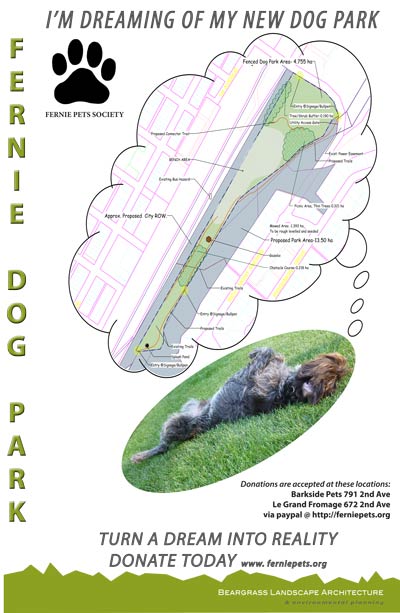Update, July 2016: Since our last post on this project, we have made strides in moving forward. Fernie Pets Society signed an agreement with the City of Fernie to utilize the Ridgemont site for a dog park.
Beargrass created a master plan specific to that site, held public meetings and wrote a design book, containing park elements as a guideline for construction.
Currently, the treed portion of the site has been thinned and grants have been received for the paved pathways and the fencing. Again, congratulations to the non-profit Fernie Pets Society for their long term dedication to this project.
Prior to March 2014:
Leslie worked with Fernie Pets Society to identify areas for a future dog park, create a master plan and facilitated City Council approval for the Ridgemont Park.
This project is similar in its approach to the Hugh Rogers WAG Park in Whitefish. It has a strong volunteer core that is active in finding an area for a permanent dog park. In September of 2012 Leslie worked with Fernie Pet’s Society to both assess current designated off leash areas and to identify areas for a new dog park. Once we had identified the pros and cons of our three different locations, Leslie met with the Fernie City Council in October of 2013 to present site evaluations and a review of the Hugh Rogers WAG Park. We received a great level of interest and positive directions, without a firm commitment. However, we had enough support to continue on with a rough proposal and plan for the Ridgemont area.
At this time, the City was preparing a Recreational Master Plan. I presented our ideas to the Landscape Architects spearheading that project, and they fully included our recommendations in their report. Once their report was approved by City Council in September 2013, we proceeded to refine our proposal and meet with City Council in January of 2014. That was exciting, as the City finally gave approval for the use of the Ridgemont Site and permission to begin discussions with city staff to define the property boundaries and the legal agreement between the Pets Society and the City.
There are challenges facing the new site, and it will be interesting to see how they are met. The City uses the site as a snow dump, and that is a valuable area for them, and a necessity for a mountain town. The site is zoned parkland and has great connections and linkages to other recreational sites and trails as well as the downtown. It is my hope that these connections and linkages are strengthened by the proposed park. At the same time there will need to be a commitment to minimize the impact of the snow dump.
There are additional environmental considerations on this site as well. The site is adjacent to a busy rail line and the site has a history of industrial and mining activity. Critical in the development of any park is the impact these former activities have on the proposed park, and it will require further environmental assessment.
Time frames are another unique challenge to this type of project. Often, it is a non-profit society that spearheads these projects, and there is a lengthy process through levels of government to get approvals and commitments, as well as obtaining funding, from a variety of sources. Frustrations can run high as this process takes time, and it is a testament to the strength of these non-profit societies to see their vision through to completion.

